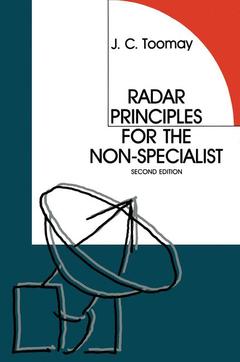Description
Radar Principles for the Non-Specialist, Softcover reprint of the original 1st ed. 1989
Author: Toomay John C.
Language: English
Keywords
Fourier series; SAR; antenna; detection; distribution; filters; interferometer; interferometry; ionosphere; nature; navigation; polarization; probability; processing; radar
Publication date: 03-2012
206 p. · 15.2x22.9 cm · Paperback
206 p. · 15.2x22.9 cm · Paperback
Description
/li>Contents
/li>
What This Book Is This book is about radar. It will teach you the essentials of radar, the underlying principles. It is not like an engineering handbook which pro vides detailed design equations without explaining either derivation or rationale. It is not like a graduate school textbook which may be abstruse and esoteric to the point of incomprehensibility. And it is not like an anthology of popular magazine articles which may be gaudy but superfi cial. It is an attempt to distill the very complex, rich technology of radar into its fundamentals, tying them to the laws of nature on one end and to the most modern and complex systems on the other. Who It's For If your work requires you to supervise or meet as coequals with radar systems engineers or designers, this book will allow you to understand them, to question them intelligently and perhaps to provide them with a perspective (a dispassionate yet competent view) that they lack. If you are trained in another discipline but have been made the man ager of a radar project or a system program that has one or more radars as sub-systems, this book will provide you with the tools you need, not only to give your team members confidence, but also to make a substantive technical contribution yourself.
1 Elementary Electromagnetics and the Radar Range Equation.- Radio Waves.- A Simple Radar.- The Radar Range Equation.- Surveillance.- Tracking.- Exercises.- References.- 2 Antennas.- A Parabolic Reflector.- The Antenna Pattern.- The Interferometer.- Finding Sidelobe Levels.- Array Radars.- Element Spacing.- Array Gain.- Array Thinning.- Array Design Considerations.- Exercises.- References.- 3 Detection and Tracking.- The Problem of Detection.- Noise Distributions.- Signal-to-Noise Ratio.- Designing Thresholds.- Some Detection Techniques.- Tracking.- Exercises.- References.- 4 Radar Cross Section.- RCS of a Sphere.- RCSs of Simple Objects.- Polarization.- Chaff Characteristics.- Diffuse Targets and Clutter.- Radar Signatures.- Exercises.- References.- 5 Waveforms and Signal Processing.- Characteristics of the Simple Pulse.- Range Measurement.- Doppler Measurements.- Pulse Compression.- Time Sidelobes.- Pulse Burst Waveforms.- Ambiguity Functions.- Signal Processing.- Exercises.- References.- 6 Electronic Countermeasures (ECM).- Mainbeam Jamming.- Sidelobe Jamming.- Low-Probability-of-Intercept Radar (LPIR).- Other Jamming Techniques.- Passive ECM.- Exercises.- References.- 7 Systems Applications.- Over-the-Horizon Radars.- Radar Altimeters.- Ionospheric Radars.- Advanced Technology Radars.- Pulse-Doppler Radars.- Synthetic Aperture Radar.- Laser Radars.- Exercises.- References.- 8 Loose Ends of Radar Lore.- Radar Horizon.- Properties of the Medium.- Ionosphere.- Troposphere.- Far Field of an Antenna.- Convenient Radar Rules of Thumb.- Exercises.- References.- 9 Radar Potentials and Limitations.- Surveillance.- Navigation.- Signatures.- Science.- Summary.- Appendix 1 Conversion to Decibels.- Appendix 2 The Electromagnetic Spectrum.- Appendix 3 Fourier Series and Transforms.- Fourier Series.- Fourier Transforms.- Appendix 4 Answers to Exercises.- Appendix 5 Glossary.
© 2024 LAVOISIER S.A.S.
These books may interest you

Fundamental Principles of Radar 135.96 €

Radar Meteorology 210.99 €

Introduction to Radar Analysis 160.25 €

